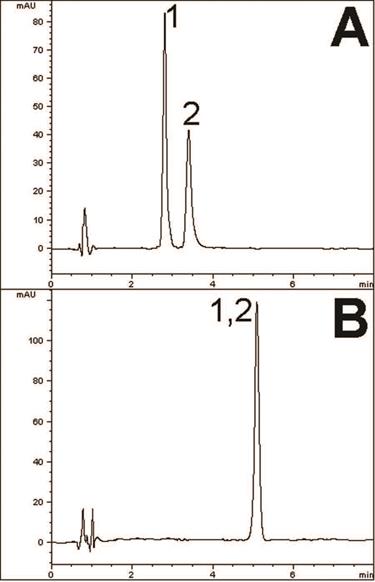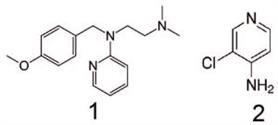Pyrilamine & 4-Amino-3-Chloropyridine analysis with HPLC - AppNote
September 1, 2016
/
/
/
/
/
/
Unique Selectivity on a Cogent Amide Stationary Phase
The Cogent Amide column offers unique selectivity that may not be readily attainable with other phases. Two test solutes shown in this application note (Pyrilamine and 4-Amino-3-Chloropyridine) were baseline separated on the Cogent Amide column (Figure A), but they co-eluted with no resolution on a different Cogent column using otherwise equivalent method conditions (Cogent Diamond Hydride™, Figure B). The presence of the Amide ligand provides additional selectivity that can make a significant difference in resolving closely- eluting compounds such as these.


Post Time: 3 minutes
Flow rate: 1.0 mL/minute
Detection: UV 244 nm
Injection vol.: 2μL
Sample Preparation:
100 mg/L Pyrilamine and 4-Amino-3-Chloropyridine reference standards in diluent of 50/50 solvent A/solvent B. Peak identities confirmed with individual standards.
Note: Amine-containing compounds such as Pyrilamine and 4-Amino-3-Chloropyridine can be difficult to analyze using conventional silica- based stationary phases. These columns have residual silanol groups on the surface that can interact electrostatically with Amines, causing peak tailing. Chromatographers use a number of strategies to avoid these issues, such as use of ion pair agents or endcapping. However, Cogent TYPE-C Silica phases are virtually free of silanols, and therefore good peak shapes can be obtained without these workaround method strategies.

Attachment
No 352 Pyrilamine and 4-Amino-3-Chloropyridine.pdf 0.4 Mb Download File
The Cogent Amide column offers unique selectivity that may not be readily attainable with other phases. Two test solutes shown in this application note (Pyrilamine and 4-Amino-3-Chloropyridine) were baseline separated on the Cogent Amide column (Figure A), but they co-eluted with no resolution on a different Cogent column using otherwise equivalent method conditions (Cogent Diamond Hydride™, Figure B). The presence of the Amide ligand provides additional selectivity that can make a significant difference in resolving closely- eluting compounds such as these.


Peaks:
1. Pyrilamine
2. 4-Amino-3-Chloropyridine
Method Conditions
Column: Cogent Amide™, 4μm, 100Å
Catalog No.: 40036-05P
Dimensions: 4.6 x 50mm
Mobile Phase:
--A: 90% DI Water / 10% Acetonitrile / 0.1% Formic Acid (v/v)
--B: B: Acetonitrile / 0.1% Formic Acid (v/v)
Gradient:
| Time (Minutes) | %B |
| 0 | 90 |
| 1 | 90 |
| 7 | 50 |
| 8 | 90 |
Flow rate: 1.0 mL/minute
Detection: UV 244 nm
Injection vol.: 2μL
Sample Preparation:
100 mg/L Pyrilamine and 4-Amino-3-Chloropyridine reference standards in diluent of 50/50 solvent A/solvent B. Peak identities confirmed with individual standards.
Note: Amine-containing compounds such as Pyrilamine and 4-Amino-3-Chloropyridine can be difficult to analyze using conventional silica- based stationary phases. These columns have residual silanol groups on the surface that can interact electrostatically with Amines, causing peak tailing. Chromatographers use a number of strategies to avoid these issues, such as use of ion pair agents or endcapping. However, Cogent TYPE-C Silica phases are virtually free of silanols, and therefore good peak shapes can be obtained without these workaround method strategies.

Attachment
No 352 Pyrilamine and 4-Amino-3-Chloropyridine.pdf 0.4 Mb Download File
